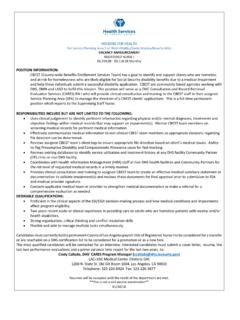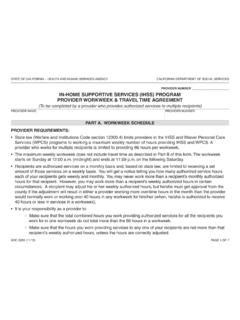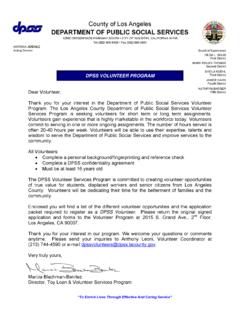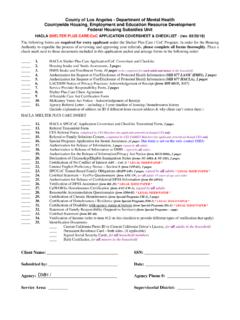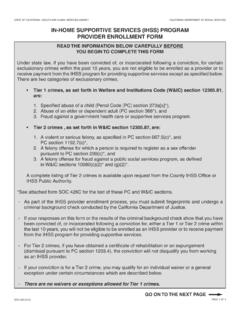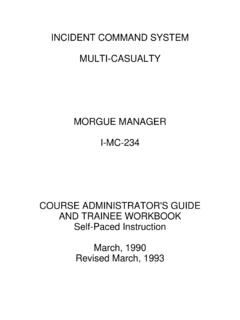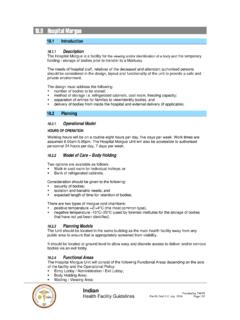Transcription of DEPARTMENT OF HEALTH SERVICES COUNTY OF LOS …
1 DEPARTMENT OF HEALTH SERVICES COUNTY OF LOS ANGELES (EMT, PARAMEDIC, MICN) SUBJECT: MULTIPLE CASUALTY INCIDENT DEFINITIONS REFERENCE NO. EFFECTIVE: 02-01-88 PAGE 1 OF 5 REVISED: 04-01-18 SUPERSEDES: 07-01-14 Decontamination (Decon): The physical and/or chemical process of removing or reducing contamination from personnel or equipment, or in some other way preventing the spread of contamination by persons and equipment. Fire Operational Area Coordinator (FOAC): Los Angeles COUNTY Fire DEPARTMENT , which is contacted through its Dispatch Center. Hazardous Material: Any solid, liquid, gas, or mixture thereof that can potentially cause harm to the human body through respiration, ingestion, skin absorption, or contact and may pose a substantial threat to life, the environment, or to property.
2 VMED28: The radio frequency is the designated MCI communication system for paramedic providers to contact the MAC. Hospital Emergency Response Team (HERT): An organized group of HEALTH care providers from a designated Level I Trauma Center, with Emergency Medical SERVICES (EMS) Agency approval as a HERT provider, who are available 24 hours/day to respond and provide a higher level of on-scene surgical and medical expertise. Incident Command Post (ICP): Location at which the primary command functions are executed and usually coordinated with the incident base. Incident Command System (ICS): A management system utilized to rapidly and efficiently manage the scene of any type of a large incident.
3 This includes a combination of facilities, equipment, personnel, procedures, and communications operating within a common organizational structure with responsibility for the management of assigned resources to effectively accomplish stated objectives pertaining to an incident. ICS Components (five major management functions): 1. Incident Command: Sets the incident objectives, strategies, and priorities and has overall responsibility at the incident or event. 2. Operations Section: Conducts tactical operations to carry out the plan. Develops tactical objectives and organization, and directs all tactical resources. 3. Planning Section: Prepares and documents the Incident Action Plan to accomplish the objectives, collects and evaluates information, maintains resource status, and maintains documentation for incident records.
4 4. Logistics Section: Provides support, resources, and all other SERVICES needed to meet the operational objectives. 5. Finance/Administration Section: Monitors costs related to the incident. Provides accounting, procurement, time recording, and cost analysis. SUBJECT: MULTIPLE CASUALTY INCIDENT DEFINITIONS REFERENCE NO. PAGE 2 OF 5 Jump START: A pediatric MCI field triage tool developed to parallel the START triage system, which adequately addresses the unique anatomy and physiology of children. Medical Alert Center (MAC): Assists provider agencies and base hospitals with patient destination decisions and multiple casualty incidents. t serves as the control point for VMED28 and ReddiNet systems.
5 Medical and HEALTH Operational Area Coordinator (MHOAC): Responsible for all medical and HEALTH operations for the operational area. The EMS Agency administrator is the designated MHOAC and is contacted through the MAC. Medical Officer on Duty (MOD): Designated medical officer on duty for the MAC. Multiple Casualty Incident (MCI): The combination of numbers of ill/injured patients and the type of injuries going beyond the capability of an entity s normal first response. National Incident Management System (NIMS): A comprehensive, national approach to incident management that is applicable at all jurisdictional levels and across functional disciplines.
6 The intent of NIMS is to be applicable across a full spectrum of potential incidents and hazard scenarios, regardless of size or complexity. The management system serves to improve coordination and cooperation between public and private entities in a variety of domestic incident management activities. Rapid Emergency Digital Data Information Network (ReddiNet): An emergency medical communications network linking hospitals, regional EMS agencies, paramedics, dispatch centers, law enforcement, public HEALTH officials, and other healthcare systems. The system provides participants with tools for managing MCIs, determining hospital bed availability, assessing available healthcare system resources, communicating emergency DEPARTMENT diversion status, participating in syndromic surveillance, and sending the network messages.
7 Simple Triage and Rapid Treatment (START): A triage system that provides guidelines for prehospital care personnel to rapidly classify victims so that patient treatment and transport are not delayed. Patients are triaged into the following categories: Deceased: Patients who do not have spontaneous respirations after repositioning the airway. Immediate: Patients who exhibit severe respiratory, circulatory, or neurological symptoms. Patients who require rapid assessment and medical intervention for survival. Delayed: Patients who are neither immediate nor minor but will require a gurney upon arrival at the hospital. Delayed patients are the second priority in patient treatment.
8 These patients require aid but injuries are less severe. Minor: Patients who are ambulatory with injuries requiring simple, rudimentary first-aid. Standardized Emergency Management System (SEMS): A system required by Government Code 806 (a), for managing responses to multi-agency and multi-jurisdictional emergencies in California. SEMS consists of five organizational levels which are activated as necessary: (1) field response; (2) local government; (3) operational area; (4) regional; and (5) state. SUBJECT: MULTIPLE CASUALTY INCIDENT DEFINITIONS REFERENCE NO. PAGE 3 OF 5 Staging Area: The location where incident personnel and equipment are assigned on a three-minute available status.
9 Triage: A system that provides guidelines for prehospital care personnel to rapidly classify victims so that patient treatment and transport are not delayed (see Ref. Nos. , and ). Triage Tag: A tag used by triage personnel to identify and document the patient s triage category. Unified Command: A team effort that allows all agencies with jurisdictional responsibility for the incident, either geographical or functional, to manage an incident by establishing a common set of incident objectives and strategies. This is accomplished without losing or abdicating agency authority, responsibility, or accountability. Key Incident Command System Positions: Air Operations Branch Coordinator: Is ground based and is primarily responsible for preparing the air operations portion of the Incident Action Plan and providing logistical support to helicopters operating on the incident.
10 Ambulance Coordinator: Reports to the Patient Transportation Unit Leader with responsibility to manage the ambulance staging area(s) and to dispatch additional ambulances/transportation resources as needed. Essential duties include establishment of appropriate staging area for ambulances; identify routes of travel for ambulances; and maintain communications with the Air Operations Branch Director regarding air ambulance transportation assignments. The position is to maintain communications with the Medical Communications Coordinator and Patient Loading Coordinator and to provide ambulances upon request. The Ambulance Coordinator is to assure that necessary equipment is available in the ambulance for patient needs during transportation, provide an inventory of medical supplies available at ambulance staging area for use at the scene, and maintain records as required and Unit/Activity Log (ICS Form 214).



